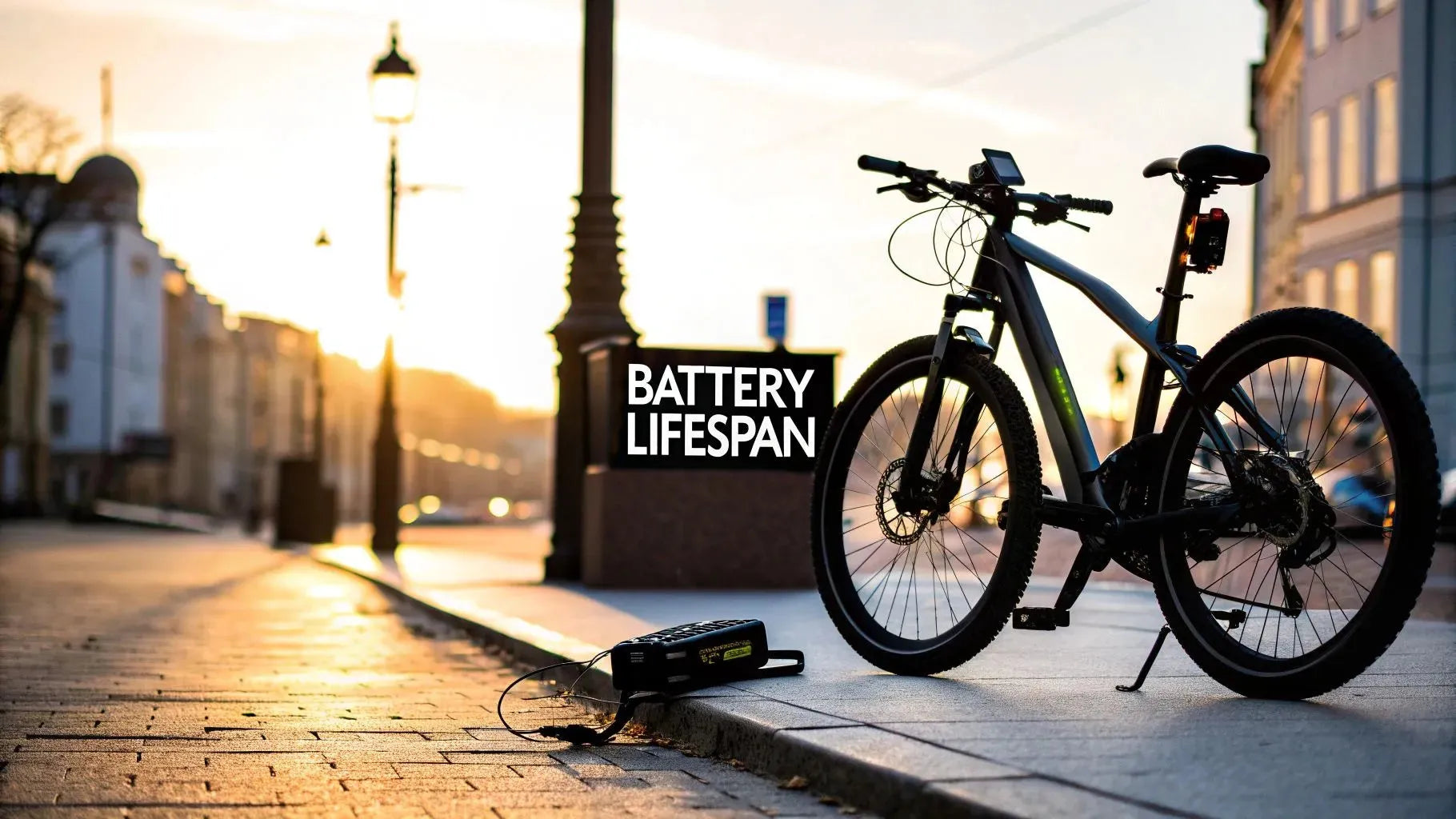So, you're wondering how long that e-bike battery is really going to last. The short answer is you can expect a solid 3 to 5 years of good performance, which works out to about 500 to 1,000 full charge cycles. This is a pretty standard benchmark you'll see across the board, whether you're buying in the US, Australia, or elsewhere.
Your Ebike Battery Lifespan: The Quick Answer
When we talk about an e-bike battery's lifespan, it's not like a lightbulb that just pops and dies one day. It’s a lot more like the battery in your phone after you've had it for a few years—it still works, but you'll notice it doesn't hold a charge quite as long as it did out of the box. This slow fade in performance is just a natural part of how these batteries age.
Basically, the battery's ability to store and deliver power slowly decreases over time. That 60-kilometre ride you used to get on a single charge might eventually become a 45-kilometre ride. It's an unavoidable process for all lithium-ion batteries, but knowing what to expect can help you get the most out of your bike for years to come.
Most modern e-bikes use lithium-ion batteries that are built to handle between 500 and 1,000 full charge cycles before their capacity drops off in a big way. For the average rider, that translates to about 3 to 5 years of reliable use. If you want to dive even deeper, you can find more insights about e-bike battery longevity from Himiway Bike.
Key Lifespan Metrics
To really get a handle on this, it helps to look at the two main ways battery life is measured:
- Charge Cycles: Think of one "cycle" as a full drain and recharge—going from 100% down to 0% and back up to 100%. Don't worry, charging from 50% to 100% twice only counts as one full cycle. Most e-bike batteries can handle hundreds of these before they start to lose their punch.
- Years: This one's easy. It's just the calendar time you can expect your battery to perform well. With regular use, a good quality battery should give you 3 to 5 years before you start thinking about a replacement.
To make things even simpler, here's a quick table breaking down what those numbers actually mean for you.
| Ebike Battery Lifespan At a Glance |
| :--- | :--- | :--- |
| Metric | Average Lifespan | What It Means For You |
| Charge Cycles | 500 - 1,000 | The number of full recharges before the battery's range starts to noticeably decrease. |
| Years | 3 - 5 years | With average riding and charging habits, this is how long you can expect reliable performance. |
| Capacity Fade | Gradual decline over time | Your battery won't suddenly die; its maximum range will just get shorter as it gets older. |
So, what’s the big takeaway here?
Your battery doesn't just switch off one day. Its "lifespan" is really just the time it can hold enough charge to be useful for your needs. When its range gets too short for your daily commute or weekend adventures, that’s the real sign it’s time for a replacement.
At the end of the day, your battery's destiny isn't set in stone. While every battery has a finite life, how you ride, charge, and store it makes a huge difference. Your habits are what will determine whether your battery calls it quits closer to year three or keeps you cruising well past the five-year mark.
What Actually Determines Battery Longevity
So, what's the secret sauce that separates an e-bike battery that conks out after three years from one that's still going strong past the five-year mark? It’s not just one magic bullet, but a handful of things working together. Once you get a feel for them, you're in the driver's seat to make your battery last as long as possible.
Think of your battery's lifespan as a three-legged stool. The legs are charge cycles (how often you charge it), mileage or kilometres (how far you ride), and good old-fashioned time, or what we call chemical age. Each one plays a critical part in how long your battery holds up.
The Three Pillars of Battery Health
Let's kick things off with charge cycles. A "cycle" isn't just every time you plug it in. It's one complete discharge from 100% all the way down to 0% and then back up. So, if you ride until your battery hits 50% and then top it off, you've only used half a cycle. Do that again tomorrow, and you've completed one full cycle.
Most decent e-bike batteries are built to handle somewhere between 500 to 1,000 full charge cycles. If you do the math, that's a lot of riding. Even for daily users, hitting that limit can easily take a few years.
Now, counting cycles is a bit technical. For most of us, especially commuters zipping around cities like Sydney or San Francisco, thinking in terms of mileage or kilometres is just plain easier. You know how far you ride, right? Let's say one full charge gets you anywhere from 30 to 80 kilometres. A battery rated for 800 cycles that averages 50 km per charge could theoretically cover a whopping 40,000 kilometres before it's toast. If you want to dive deeper into this, Biktrix has a great article explaining how mileage and cycles connect.
This infographic gives a nice, clean visual of these three ways we measure a battery's lifespan: cycles, years, and total distance.

As you can see, they're all just different ways of looking at the same thing: how much life you can expect to get out of that battery.
The Unavoidable Factor: Chemical Aging
Finally, we have to talk about chemical aging. Like all of us, batteries get older, whether they're being used or not. The lithium-ion cells inside are constantly in a slow state of decline, gradually losing their ability to hold a full charge. Even a brand-new battery sitting on a shelf is aging. You can't stop this process entirely, but you can definitely slow it down.
The key takeaway is that your battery's lifespan isn't set in stone. It's a direct result of how you charge it, how much you ride, and how you store it. Getting a handle on these things is the first real step to getting more miles for your money.
By juggling these three pillars—smart charging habits, keeping an eye on your mileage, and slowing down the aging process with proper storage—you can have a massive impact on your battery's health. It’s all about being proactive to make sure you and your e-bike have a long, happy life together.
Why All Ebike Batteries Eventually Fade
Every e-bike battery, from the second it rolls off the assembly line, has a finite lifespan. It’s on a one-way journey, and its internal chemistry has already started a slow, inevitable decline. This isn't a flaw in your bike—it's just the nature of the beast for the lithium-ion technology that powers our rides.
I like to think of a brand-new battery as a fresh, sturdy bucket filled to the top with water. Every time you charge it and head out for a ride, you’re poking a tiny, microscopic hole in the side. Over hundreds of rides, those little holes add up, and the bucket just can't hold as much water as it used to.
Understanding Capacity Fade
This slow decline in a battery's ability to hold a full charge is what we call capacity fade. It’s the reason that awesome 40-mile range you celebrated on day one might feel more like 30 miles after a couple of years of daily use. Your battery isn't broken; its maximum storage space has just permanently shrunk a bit.
This happens with every single charge and discharge cycle. As the lithium ions inside do their dance to create power, they cause tiny, irreversible bits of wear and tear on the battery's internal structures. It's a fundamental part of how these batteries work and a huge factor in how long they last out in the real world.
When we say a battery is "dead," it's rarely because it won't turn on at all. It's more accurate to say its capacity has faded so much that it can no longer give you a useful range for your ride. It simply can't store enough juice to be practical anymore.
The Numbers Behind the Fade
This isn't just a feeling; it's a measurable process. Battery makers use a metric called capacity retention to grade their products. For instance, a quality battery is often rated to retain 60–80% of its original capacity after 500 full charge cycles.
So, what does that mean for you? A battery that once gave you a solid 50-mile range might now top out at 30-40 miles on a full charge. If you want to dive deeper into the science, the team at Ariel Rider has a great post that explores how capacity fade impacts performance.
This gradual fade is, by far, the most common reason people end up buying a new battery. The old one still works, sure, but it just can't keep up with their commute or weekend adventures anymore. Knowing this from the start helps set realistic expectations for your e-bike as it gets older, so you're not caught by surprise down the road.
Practical Habits To Extend Your Battery Life

Sure, every battery has an expiration date, but you have a ton of influence over when that day comes. The way you ride, charge, and store your bike are the biggest factors in whether that battery gives you three great years or pushes well past five.
These aren't complex engineering secrets, just smart, simple practices that pay off big time. Think of it like your own health—good habits lead to a longer, healthier life, while neglect and stress wear things out much faster.
The best part? These habits are easy to pick up and will quickly feel like second nature, adding years to your battery's lifespan.
The Goldilocks Rule of Charging
If you want to make a real impact, start with your charging routine. For the lithium-ion batteries in our bikes, the magic zone for daily use is keeping the charge between 20% and 80%. We call this the 'Goldilocks Rule'—it's not too full, not too empty, but just right.
Constantly juicing it up to 100% or letting it die completely puts unnecessary stress on the battery cells, which makes them age faster. It's totally fine to charge it to full for a big day out, but doing it every single day will shorten its overall life.
Treat 80% as your new "full" for regular rides and plug it in before it dips below 20%. This one simple change can dramatically increase the number of healthy charge cycles you get.
And please, stick with the original charger that came with your bike. A cheap knock-off from Amazon might seem like a bargain, but it can supply the wrong voltage and lack critical safety features, risking permanent damage.
Ride Smoother and Mind the Temperature
How you ride matters just as much as how you charge. Every time you cruise on a lower pedal-assist level, you’re putting less strain on the battery. Think of it like driving a car—flooring it at every green light burns way more fuel. Smooth, gradual acceleration is your battery's best friend.
Temperature is the other big one. Extreme heat and cold are absolute enemies of a happy battery. Never, ever leave your battery cooking in a hot car during a Texan summer or freezing in a garage overnight during a Melbourne winter.
- Avoid Extreme Heat: High temps can permanently damage the battery cells.
- Avoid Extreme Cold: Frigid weather will temporarily zap your battery's range and power.
- Store Indoors: When you're not riding, bring your battery inside where it's at a comfortable room temperature.
To make it even clearer, here’s a quick comparison of good versus bad battery habits.
Smart Habits For A Healthier Ebike Battery
This table breaks down the simple dos and don'ts that can make or break your battery's lifespan.
| Habit | Bad Practice (Shortens Lifespan) | Good Practice (Extends Lifespan) |
|---|---|---|
| Charging Range | Charging to 100% and draining to 0% daily. | Keeping the charge between 20% and 80% for regular use. |
| Charger Choice | Using a cheap, third-party charger. | Always using the original manufacturer's charger. |
| Riding Style | Aggressive starts and constant high-assist modes. | Smooth acceleration and using lower assist levels. |
| Storage | Leaving the battery in a hot car or cold garage. | Storing the battery indoors at room temperature. |
Following the "Good Practice" column will keep your battery performing at its best for years.
These simple, practical tips are the bedrock of good battery care. For a deeper dive, check out our complete guide on extending your electric bike battery life. Make these habits part of your routine, and you’ll get thousands of reliable miles from your e-bike.
Spotting The Signs Of A Failing Battery
So, how do you know when your e-bike battery is getting a bit tired and starting to head for retirement? Luckily, batteries rarely just give up the ghost without any warning. Your bike will start dropping some pretty clear hints long before it leaves you stranded on a hot afternoon with a long walk home.
Learning to read these signals is the key. It's the difference between being prepared and getting caught out.
The most glaringly obvious sign is a dramatically reduced range. Remember that 40-mile loop you used to smash on a single charge? If you're now needing a mid-ride top-up to get home, your battery’s capacity is definitely fading. It's the clearest sign that the internal cells just can't hold the same amount of juice they once did.
It's Not Just About Shorter Rides
While a shrinking range is the number one symptom, it's not the only clue. Other little quirks can also point to a worn-out battery, and paying attention to these subtle changes gives you a much better picture of its overall health.
Keep an eye out for these other red flags:
- Loses Charge When Idle: You pull your fully charged battery off the shelf, but when you go to ride a day or two later, it’s already dropped to 80% or less. This is a classic sign it can no longer hold its charge effectively.
- Charges Way Too Fast: A battery that goes from empty to full in a fraction of its usual time isn't a good thing. It often means the battery's capacity has diminished so much that there's simply less "space" for the electricity to fill.
- Sudden Power Cut-Outs: Does your motor suddenly die on you when you're tackling a steep hill or accelerating hard from a standstill? An aging battery can struggle to deliver the high current needed for these demanding moments, causing the whole system to shut down to protect itself.
Recognizing these signs early allows you to plan ahead. Instead of being caught by surprise, you can research and purchase a new battery on your own terms, ensuring you’re never left without your ride when you need it most.
If you start noticing one or more of these things happening regularly, it's a strong signal that your battery’s journey is coming to an end. It doesn’t mean your e-bike is done for—not at all! It just means its powerhouse needs a refresh.
How To Store Your Ebike Battery Correctly

Believe it or not, what happens when your bike is parked is just as important as how you ride it. If you're putting your e-bike away for the winter or just know you won't be riding for a few weeks, bad storage habits can quietly wreck your battery's health, permanently shortening its life.
Think of it like putting your battery into a comfortable hibernation. You don't want it stuffed full, but you don't want it starving either. Leaving a battery at 100% for weeks on end puts a ton of stress on the cells, and letting it drop to 0% risks a "deep discharge" state it might never wake up from.
The golden rule here is to keep the battery partially charged.
The sweet spot for long-term storage is between 40-60% charge. This is the happy place where the battery's internal chemistry is most stable, slowing down the natural aging process that happens even when it's just sitting there.
A few simple rules will keep your battery healthy during its downtime so it's ready to go when you are.
Long-Term Storage Best Practices
Okay, so you've got the charge level sorted. But where you store it is just as critical. Extreme temperatures are the absolute enemy of a lithium-ion battery. A frigid, damp garage or a sun-drenched porch are basically torture chambers for your battery cells, causing irreversible damage.
Instead, always follow these simple guidelines:
- Find a Cool, Dry Place: Bring that battery inside! A closet, a utility room, or under a bed are all great spots. The key is a stable, moderate temperature, so avoid places like a garage that freezes in winter or gets scorching hot in summer.
- Avoid Direct Sunlight: Keep the battery away from windows or any place where the sun can beat down on it and cause it to heat up.
- Check It Monthly: This is a big one. Set a reminder on your phone to check the battery's charge level once a month. If you see it's dipped below 40%, just plug it in for a little while to get it back into that 40-60% sweet spot.
These simple habits will save you from the most common (and costly) storage mistakes. For more ideas on how to manage your bike and gear, our complete guide to electric bike storage solutions has a ton of practical advice.
Got Ebike Battery Questions? We've Got Answers
So, you've got an ebike, or you're thinking about getting one, and the battery is probably the biggest question mark. It's the heart of the machine, after all. Let's clear up some of the most common things riders ask us about.
One question we hear all the time is about charging. Is it okay to just plug it in and leave it charging overnight?
While modern chargers are pretty smart and have safety features to stop overcharging, it's not the best habit for your battery's long-term health. Keeping it constantly topped up to 100% puts a little bit of extra stress on the cells. Think of it like a muscle that's always tensed. The best practice? Just unplug it once it's full.
What About Costs and Nasty Weather?
Another big one is replacement cost. "How much is a new ebike battery?" is something we get asked a lot. The truth is, the price can vary significantly.
Costs in the US and Australia can fall anywhere between $400 and over $1,000 USD/AUD. What really drives the price is the brand (think big names like Bosch or Shimano) and the battery's capacity—not necessarily the country you buy it in. To get a better handle on the full cost of ownership, check out our guide on electric vehicle maintenance costs.
Here's the bottom line: a high-capacity battery from a top-tier brand will cost more, no matter where you are. It’s all about the tech inside.
And finally, a classic concern for riders everywhere: can you ride your ebike in the rain? What happens if you get caught in a downpour?
Good news—you don't have to pack it in at the first sign of drizzle. But there are a few ground rules:
- Water-Resistant is the Word: Your ebike battery is built to be water-resistant. That means it can handle rain, splashes from puddles, and general wet-weather riding just fine.
- Don't Go for a Swim: Resistant doesn't mean waterproof. You should absolutely avoid riding through deep water that could completely submerge the battery or motor.
- Step Away from the Pressure Washer: Whatever you do, never use a jet wash or high-pressure hose to clean your bike. That intense spray can blast water past the seals and into the sensitive electronics, causing some seriously expensive damage.
At Punk Ride, our goal is to make sure you get the absolute most out of every ride. Ready to find your perfect set of wheels? Check out our handpicked selection of top-brand electric bikes and scooters at https://www.punkride.com.





Share:
e scooter vs ebike: The Ultimate Commuter Showdown
Decoding Electric Scooter Range